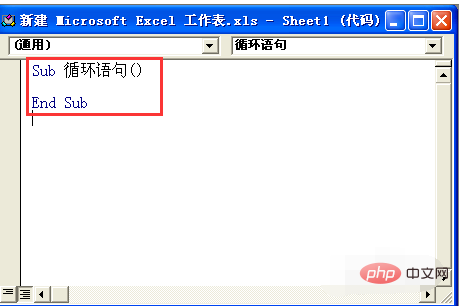What is the usage of for loop statement in Excel VBA?
- coldplay.xixiOriginal
- 2020-06-28 11:07:0811691browse
Usage of for loop statement in vb: 1. [for..next] statement, the structure judged by i is [for i=initial value to end value step step value]; 2. [for each. .next] statement is an object variable, and its structure is [For each object variable in object collection].

Usage of for loop statement in vb:
1. There are two commonly used for loop statements, One is the for…next structure; the other is the For each…next structure. These two structures are mainly used when looping through multiple data. So below I will introduce the specific usage of the two loop structures respectively. First, you need to open the VBA editor

2, for...next Structure
This structure is generally like this:
for i=initial value to end value step step value
……
next
To explain in detail, the initial value refers to the value at the beginning of the loop, and the end value refers to the value at the end of the loop. In essence, it is a judgment that i is worthy. If the i value is between the starting value and the end value, then enter Loop statement, and then the i value will automatically add a step value every time it runs to the next statement. The loop will not end until the i value exceeds the range from the initial value to the end value. It should be noted here that the "step value" is often omitted. If omitted, the default value of the step is 1. The following will use a small example to specifically illustrate the usage of this structure:
Example: Output the numbers 1 to 10 at a time in the sheet1 worksheet and display them in the first column.
Program:
Sub 循环语句() Dim i As Integer For i = 1 To 10 Cells(i, 1) = i Next End Sub

For loop structure with a step size of 2
Let’s take a look at a sample program here
Program:
Sub 循环语句()
Dim i As Integer
For i = 1 To 10 Step 2
Cells(i, 1) = i
Next
End Sub
For loop structure with a step size of -1
Here we look at the same thing when the step value is - 1, what will the procedure be like?
Look at the example program below:
Sub 循环语句()
Dim i As Integer
For i = 10 To 1 Step -1
Cells(i, 1) = i
Next
End Sub
for each...next Structure
Sub 循环语句()
Dim i As Integer
For Each c In Range("a1:c5")
i = i + 1
c.Value = i
Next
End Sub

Sub 循环语句()
Dim i, j As Integer
For i = 1 To 9
For j = 1 To i
Cells(i, j) = i & "*" & j & "=" & i * j
Next
Next
End Sub

excel basic tutorial》
The above is the detailed content of What is the usage of for loop statement in Excel VBA?. For more information, please follow other related articles on the PHP Chinese website!

